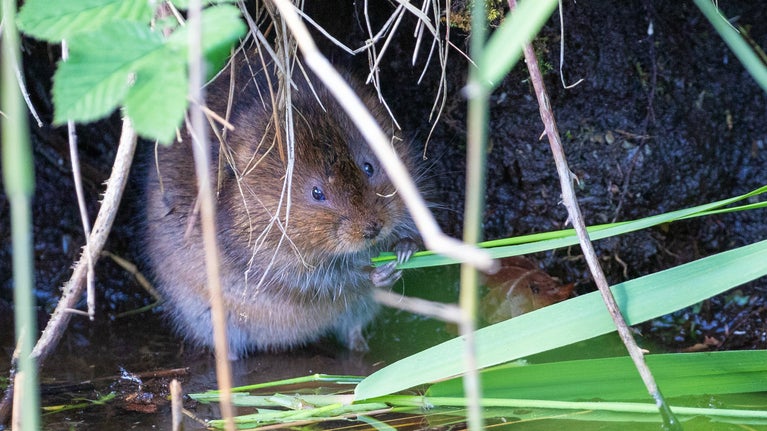£5m of funding from Garfield Weston Foundation will help ‘turn the tide’ for nature on a huge scale says the National Trust
- Published:
- 28 March 2025

The battle against both the nature and climate crises is being stepped up on land cared for by the National Trust at four locations in England, as a new three-year project to deliver landscape scale nature conservation gets underway.
The battle against both the nature and climate crises is being stepped up on land cared for by the National Trust at four locations in England, as a new three-year project to deliver landscape scale nature conservation gets underway.
Thanks to funding support of £5m from the Garfield Weston Foundation [1], ‘Turning the tide for nature’, will create landscapes rich in wildlife and take action to reduce the impact of climate change at Arlington Court in North Devon, Wallington in Northumberland and areas of the Peak District and Yorkshire Dales.
By 2028 approximately 4164 hectares (10289 acres), an area similar in size to Portsmouth [2], of habitats will be restored or created [3]. This includes priority habitats [4] such as blanket bog in peatlands, wetlands, wood pasture, grasslands and rivers.
Many of the UK’s most threatened and endangered wildlife including water vole, pine marten, red squirrel and white-clawed crayfish are also set to benefit from the ambitious project.
Ben McCarthy, Head of Nature and Restoration Ecology at the National Trust said: “As Europe’s largest conservation charity, we have the responsibility to think big and take bold action for nature and the climate across the land in our care.
“The locations selected here have huge potential to dramatically increase the benefit they offer for boosting biodiversity and capturing carbon at a landscape scale. By taking impactful actions on the ground, working with others and with support from funders like the Garfield Weston Foundation, we will create bigger, better and more joined up habitats rich in wildlife.”
Over the next three years funding from the Garfield Weston Foundation will help create a wilder, wetter and woodier landscape in North Devon. This includes 75 hectares (185 acres) of woodland to encourage the natural expansion of woodland specialists, like the pine marten, into the estate and longer term, the reintroduction of rare red squirrels.
In addition, a new multi-user trail will be added to the planned innovative Outdoor Hub at North Woolley on the Arlington Court estate [5]. Access to nature across 50 hectares (124 acres) of woods, wetland and meadows will be opened up for all, from cyclists to wheelchair users and from walkers to pushchairs.
In the High Peak area of the Peak District the funding will enable and protect large scale restoration works over 3024 hectares (7472 acres) of moorland habitat, including 1000 hectares (2471 acres) of degraded blanket bog. A healthy, sufficiently wet bog will be able to trap carbon, store rainwater and provide homes for wildlife like golden plover, dragonflies and lizards.
Funding will help protect moorland areas where a mix of plants such as bilberry will grow, as well as the sheltered valleys and cloughs along the moor edges where work will take place to establish trees like silver birch and hazel. This will stabilise the soil and help to reduce the risk of flooding lower down the valley.
In the Yorkshire Dales the Trust will continue to work with the Yorkshire Peat Partnership and Defra to plan for and restore 600 hectares (1482 acres) of precious peatland at Upper Wharfedale and Malhamdale back to a healthy, saturated state.
The once common, lady's slipper orchid will be reintroduced to stretches of the Dales' woodlands to benefit bees and butterflies. Native broadleaf trees will be returned to the landscape including the increasingly scarce rock whitebeam to higher ground, and 'soil to sky' wide baseline monitoring will track the project’s successes for species, habitats and soils.
At Wallington, the largest intact contiguous estate the Trust cares for, the Fallowlees Burn (river) corridor [6] will be transformed by the restoration of 70 hectares (173 acres) of land, creating wetlands, woods and grasslands. The mosaic of habitats reaching out from the river’s banks will improve its health and support the possible return of water voles following a feasibility study.
Funding will also enable the creation of a third ark site at Wallington for white-clawed crayfish, the UK’s only native crayfish. This will add to the two ark sites already established on the Northumberland estate, one in 2022 and the other last year to help safeguard the species.
Sophia Weston, Deputy Chair, Garfield Weston Foundation added: “We recognise that nature is in trouble in the UK and in need of urgent help. The steps the National Trust takes now to carry out vital conservation work across some of the country’s most cherished landscapes will ensure that nature can thrive in the future”.
Project funding will further support the development of an evidence-based approach to monitoring so impacts of interventions on nature, climate and people can be clearly demonstrated, replicated and scaled up elsewhere across the Trust.
The ‘Turning the tide for nature’ project directly contributes to the National Trust’s ambition to create 250,000 hectares of nature-rich landscapes, an area one-and-a-half times the size of Greater London, both on Trust land and off it in the next decade. This goal is set to be the biggest contribution made by the Trust, to date, in addressing the catastrophic decline in nature across England, Wales and Northern Ireland.